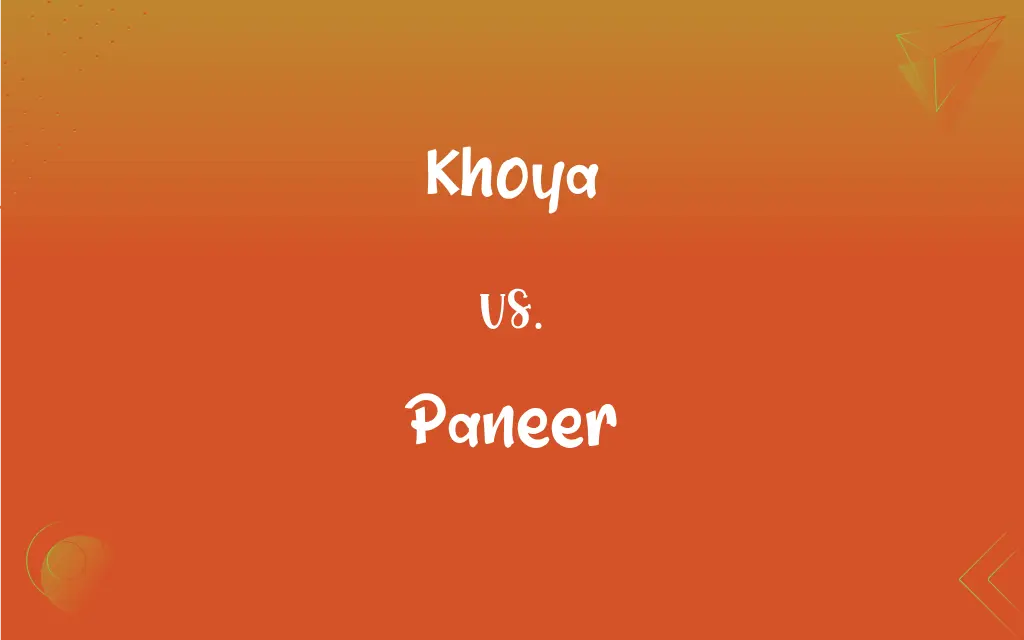Khoya vs. Paneer: What's the Difference?
By Janet White & Harlon Moss || Published on March 4, 2024
Khoya is a milk product thickened by heating, used in sweets, while paneer is a fresh cheese common in South Asian cuisine, made by curdling milk.

Key Differences
Khoya, also known as mawa, is made by simmering full-fat milk for hours until it reduces to a thick, granular paste. It's essential in many traditional Indian and Pakistani desserts. Paneer, on the other hand, is fresh, unaged cheese created by curdling milk with a food acid, such as lemon juice or vinegar, and then pressed to remove excess water.
Khoya is characteristically sweet and dense, offering a rich base for sweets like barfi and gulab jamun. Its concentrated milk flavor enhances the sweetness of desserts. Paneer is versatile, used in savory dishes like palak paneer or as a fried snack. Its mild, milky flavor complements spices and gravies in Indian cuisine.
The production of khoya involves a long, slow cooking process, concentrating the milk's solids. This method imparts a unique taste and texture that's hard to substitute. Paneer’s production is quicker, relying on acid to separate curds from whey, resulting in a soft, crumbly cheese that can be sliced or crumbled.
Khoya's texture varies from soft to hard, depending on its moisture content and the duration of cooking. It can be used as a primary ingredient in sweets or as a thickener in rich gravies. Paneer's texture is firm yet soft, ideal for absorbing flavors and adding substance to dishes.
Both are derived from milk, their uses in cuisine are distinct. Khoya is predominantly used in desserts for its sweet, dense qualities. Paneer serves as a protein-rich addition to meals, offering a mild flavor that pairs well with various ingredients.
ADVERTISEMENT
Comparison Chart
Origin
Thickened milk by heating
Curdled milk with food acid
Texture
Thick, granular paste
Soft, crumbly cheese
Use in Cuisine
Sweets and desserts
Savory dishes and snacks
Flavor
Sweet, rich milk flavor
Mild, milky
Cooking Process
Slow simmering of milk
Curdling milk and pressing
ADVERTISEMENT
Khoya and Paneer Definitions
Khoya
Varies in texture from soft to hard, depending on its moisture content.
For this recipe, you'll need hard khoya, which is ideal for grating.
Paneer
A fresh, unaged cheese common in South Asian cuisine.
Paneer is often added to spinach for the classic dish palak paneer.
Khoya
A milk-based food ingredient, thickened through slow cooking.
Khoya is often used to make traditional Indian sweets like peda.
Paneer
Made by curdling milk with a food acid and pressing.
To make paneer, lemon juice is added to boiling milk to separate the curds.
Khoya
Known for its sweet, concentrated milk taste.
The khoya added a delicious milky sweetness to the barfi.
Paneer
Has a mild, milky flavor that absorbs spices well.
The paneer perfectly absorbed the rich tomato gravy's flavors.
Khoya
Made by simmering full-fat milk for several hours.
Making khoya at home requires patience, as the milk needs to simmer until thick.
Paneer
Offers a soft, crumbly texture that can be sliced or crumbled.
She sliced the paneer into cubes for the curry.
Khoya
Essential for many Indian desserts, providing a rich, creamy texture.
She used khoya to give the halwa its characteristic richness.
Paneer
Can be used in savory dishes or fried as a snack.
Fried paneer cubes add a delicious texture to the salad.
Paneer
A soft unsalted and unripened cheese made from milk that is simmered, curdled using lemon juice, vinegar, yogurt, or a similarly acidic substance, and then drained and pressed in cheesecloth.
Paneer
A soft, non-matured, Indian cheese.
The spinach was mixed with paneer to make a satisfying meal.
FAQs
How is paneer made?
Paneer is made by curdling hot milk with an acid like lemon juice or vinegar, then pressing the curds to form a soft cheese.
Can khoya be used in savory dishes?
While khoya is mainly used in sweets, it can also be added to rich gravies for texture and flavor.
Is paneer a good source of protein?
Yes, paneer is a good source of protein, making it a popular choice in vegetarian diets.
How does the texture of khoya affect its use in recipes?
The texture of khoya, which can range from soft to hard, determines its suitability for different types of sweets and desserts.
Can paneer be eaten raw?
Yes, paneer can be eaten raw and is often enjoyed in salads or as a snack.
What is khoya?
Khoya is a dairy product made by thickening milk through prolonged simmering, used primarily in South Asian sweets.
What makes khoya sweet?
Khoya's sweetness comes from the natural sugars in milk that concentrate during the simmering process.
How does the flavor of paneer complement Indian dishes?
Paneer's mild flavor makes it an excellent base for absorbing the rich spices and gravies of Indian cuisine.
What is the difference between khoya and paneer in terms of nutrition?
Khoya is richer in fats and sugars due to the concentration of milk, while paneer provides protein with less fat content.
Can lactose-intolerant people consume khoya or paneer?
Depending on individual tolerance, some lactose-intolerant people might manage small amounts of paneer better than khoya due to its fermentation process.
How does the preparation time for khoya compare to paneer?
Preparing khoya takes significantly longer due to the slow reduction of milk, while paneer can be made relatively quickly by curdling milk.
Is it possible to make khoya or paneer at home?
Both khoya and paneer can be made at home with milk, requiring simmering for khoya and acid curdling for paneer.
How do you store khoya and paneer?
Khoya and paneer should be stored in the refrigerator, with paneer immersed in water to keep it fresh.
Why is khoya a preferred ingredient in traditional Indian sweets?
Its dense texture and ability to add richness and sweetness make khoya a staple in many traditional Indian sweets.
How do you know when khoya is ready during cooking?
Khoya is ready when the milk reduces to a thick paste that leaves the sides of the pan, indicating most moisture has evaporated.
Can paneer be frozen for long-term storage?
Yes, paneer can be frozen, though it may change the texture slightly, making it a bit crumblier upon thawing.
What are the health benefits of consuming paneer?
Paneer is rich in protein, calcium, and phosphorus, supporting bone health and muscle maintenance.
Can paneer be used in desserts?
While less common, paneer can be used in some desserts, especially those requiring a mild cheese.
Are there any vegan alternatives to khoya and paneer?
Yes, there are vegan alternatives made from nuts or soy products that mimic the texture and flavor of khoya and paneer.
What are some common dishes made with paneer?
Dishes like palak paneer, paneer butter masala, and paneer tikka are popular in Indian cuisine.
About Author
Written by
Janet WhiteJanet White has been an esteemed writer and blogger for Difference Wiki. Holding a Master's degree in Science and Medical Journalism from the prestigious Boston University, she has consistently demonstrated her expertise and passion for her field. When she's not immersed in her work, Janet relishes her time exercising, delving into a good book, and cherishing moments with friends and family.
Co-written by
Harlon MossHarlon is a seasoned quality moderator and accomplished content writer for Difference Wiki. An alumnus of the prestigious University of California, he earned his degree in Computer Science. Leveraging his academic background, Harlon brings a meticulous and informed perspective to his work, ensuring content accuracy and excellence.







































































